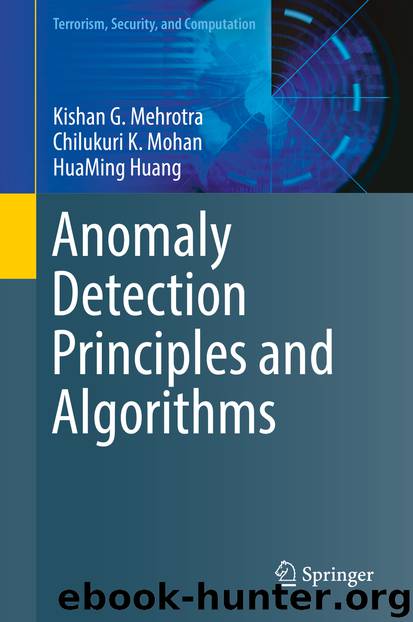Anomaly Detection Principles and Algorithms by Kishan G. Mehrotra Chilukuri K. Mohan & HuaMing Huang

Author:Kishan G. Mehrotra, Chilukuri K. Mohan & HuaMing Huang
Language: eng
Format: epub
Publisher: Springer International Publishing, Cham
6.1 Distance from the Rest of the Data
The simplest anomaly detection algorithms are based on the assumptions about the data distribution, e.g., that data is one-dimensional and normally distributed with a mean of and standard deviation of σ. A large distance from the center of the distribution implies that the probability of observing such a data point is very small. Since there is only a low probability of observing such a point (drawn from that distribution), a data point at a large distance from the center is considered to be an anomaly. More specifically, in such simple cases, anomaly detection algorithms may rely on the fact that, as z increases, the number of data points found at a distance of zσ away from decreases rapidly. For instance, only about 0.1% of the data points exceed , and this can be used to justify the following well-known criterion for detecting an outlier: If a data point is z (typically z = 3) or more standard deviations away from the arithmetic mean, then it is an outlier.
Download
This site does not store any files on its server. We only index and link to content provided by other sites. Please contact the content providers to delete copyright contents if any and email us, we'll remove relevant links or contents immediately.
| Computer Vision & Pattern Recognition | Expert Systems |
| Intelligence & Semantics | Machine Theory |
| Natural Language Processing | Neural Networks |
Algorithms of the Intelligent Web by Haralambos Marmanis;Dmitry Babenko(16235)
Jquery UI in Action : Master the concepts Of Jquery UI: A Step By Step Approach by ANMOL GOYAL(9387)
Test-Driven Development with Java by Alan Mellor(7735)
Data Augmentation with Python by Duc Haba(7609)
Principles of Data Fabric by Sonia Mezzetta(7378)
Learn Blender Simulations the Right Way by Stephen Pearson(7294)
Microservices with Spring Boot 3 and Spring Cloud by Magnus Larsson(7137)
Hadoop in Practice by Alex Holmes(6587)
RPA Solution Architect's Handbook by Sachin Sahgal(6516)
The Infinite Retina by Robert Scoble Irena Cronin(6216)
Big Data Analysis with Python by Ivan Marin(5933)
Life 3.0: Being Human in the Age of Artificial Intelligence by Tegmark Max(5516)
Pretrain Vision and Large Language Models in Python by Emily Webber(4894)
Infrastructure as Code for Beginners by Russ McKendrick(4653)
Functional Programming in JavaScript by Mantyla Dan(4436)
WordPress Plugin Development Cookbook by Yannick Lefebvre(4382)
The Age of Surveillance Capitalism by Shoshana Zuboff(4245)
Embracing Microservices Design by Ovais Mehboob Ahmed Khan Nabil Siddiqui and Timothy Oleson(4148)
Applied Machine Learning for Healthcare and Life Sciences Using AWS by Ujjwal Ratan(4135)
